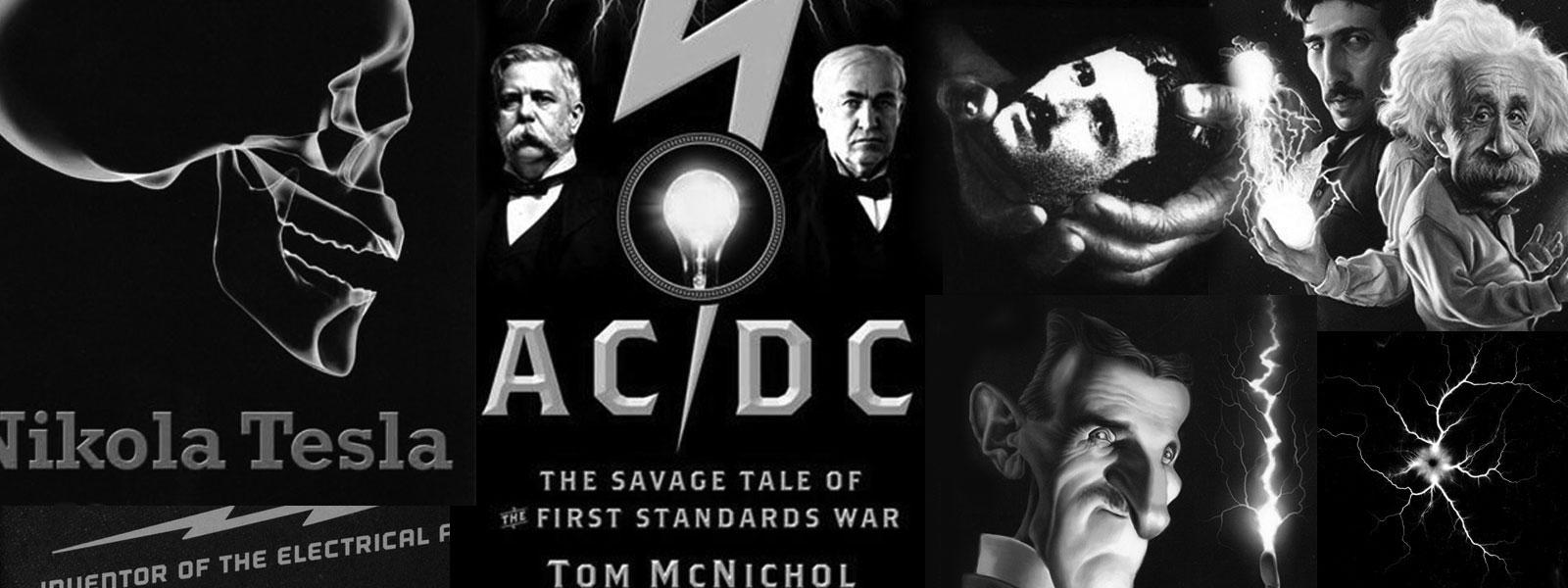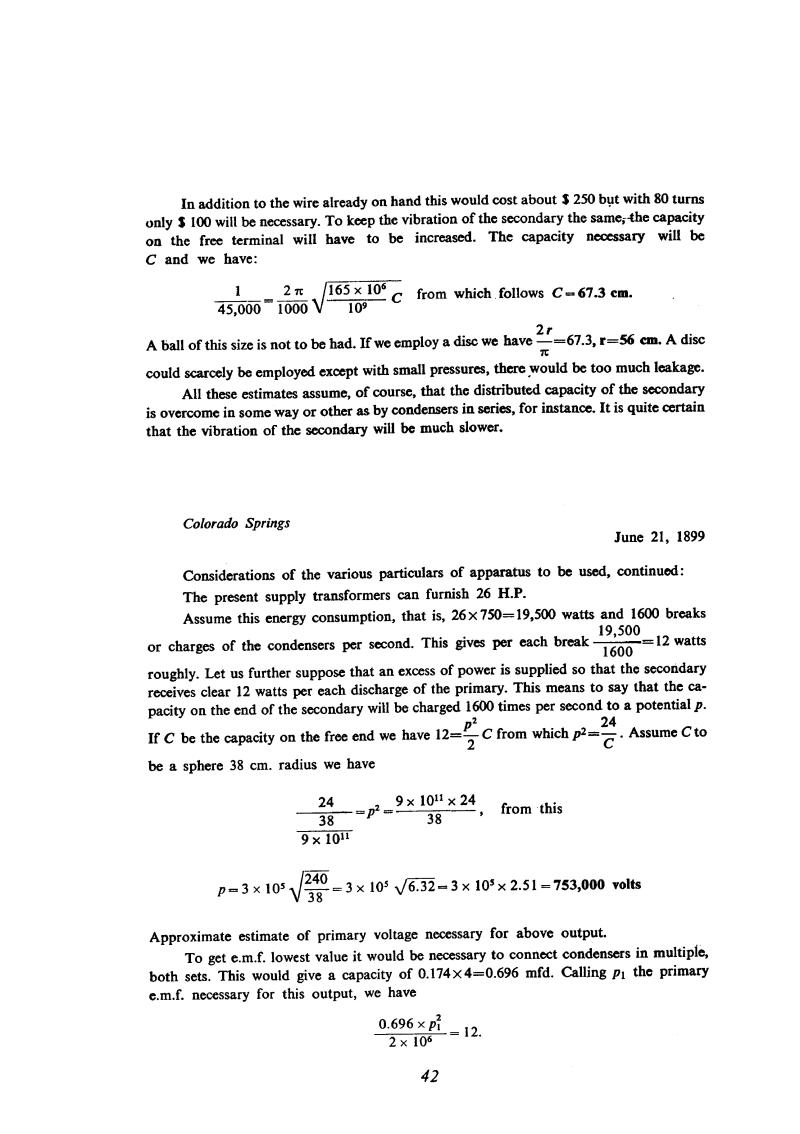
Nikola Tesla Books
In addition to the wire already on hand this would cost about $250 but with 80 turns only $100 will be necessary. To keep the vibration of the secondary the same, the capacity on the free terminal will have to be increased. The capacity necessary will be C and we have:
$! {{1 \over 45,000} = {2 \pi \over 1000} {\sqrt {{165 \times 10^{6}} \over 10^{9}} C}} $! from which follows C = 67.3 cm.
A ball of this size is not to be had. If we employ a disc we have $! {2_{r} \over \pi} $! = 67.3, r = 56 cm. A disc could scarcely be employed except with small pressures, there would be too much leakage.
All these estimates assume, of course, that the distributed capacity of the secondary is overcome in some way or other as by condensers in series, for instance. It is quite certain that the vibration of the secondary will be much slower.
Colorado Springs
June 21, 1899
Considerations of the various particulars of apparatus to be used, continued:
The present supply transformers can furnish 26 H.P.
Assume this energy consumption, that is, 26 x 750 = 19,500 watts and 1600 breaks or charges of the condensers per second. This gives per each break $! {19,500 \over 1600} $! = 12 watts roughly. Let us further suppose that an excess of power is supplied so that the secondary receives clear 12 watts per each discharge of the primary. This means to say that the capacity on the end of the secondary will be charged 1600 times per second to a potential p. If C be the capacity on the free end we have 12 = $! {p^{2} \over 2} $! C from which p2 = $! {24 \over C} $!. Assume C to be a sphere 38 cm. radius we have
$! { {{24 \over 38} \over {9 \times 10^{11}} } = p^{2} = {{9 \times 10^{11} \times 24} \over 38}} $!, from this
$! {p = 3 \times 10^{5} {\sqrt {240 \over 38}} = 3 \times 10^{5} {\sqrt {6.32}} = 3 \times 10^{5} \times 2.51 } $!= 753,000 volts
Approximate estimate of primary voltage necessary for above output.
To get e.m.f. lowest value it would be necessary to connect condensers in multiple, both sets. This would give a capacity of 0.174 x 4 = 0.696 mfd. Calling p1 the primary e.m.f. necessary for this output, we have
$! {{0.696 \times p_{1}^{2}} \over {2 \times 10^{6}}} $! = 12.
42
June 20
Tesla did not do the strict theoretical analysis of his oscillator operation, but he determined all essential elements on a simplified oscillator model. Following that procedure he determined the power which oscillator takes from the network by means of a primary circuit capacitor energy multiplied by capacitor discharges per second. By this method it is assumed that the energy in capacitor prior to each discharge is the same (that cannot be when the supply is provided from alternating current source) and that all capacitor energy is used up between two successive discharges.
The vibration, i.e., oscillator primary circuit resonant frequency he calculates from measured value of primary inductance and primary capacitance. The primary consists of two turns (please see June 17). When he uses one turn the previously determined primary inductance he divides by four. The capacitance is somewhat higher than the one measured on June 18 with old "jars". From so determined inductance and capacitance values he determines the primary circuit oscillation period by means of Thomson's equation for circuit without losses. Following his calculation method, Tesla calculates wavelength on the basis of oscillator primary circuit period and from there he finds secondary number of turns so that secondary wire length is one quarter of wavelength (please see comment on June 18). With two primary turns, when the primary inductance is approximately four folded, the period is doubled, he makes a judgment that 80 turns will be required. The inductance of a secondary with 80 turns he estimates on the basis of known inductance of a secondary with 12 turns (please see June 18), considering that the ratio of the inductances is equal to the ratio of corresponding number of turns squared. From this estimated inductance and assuming that the secondary does not have distributed capacitance and that the only capacitance in the secondary circuit originates from the metal sphere, Tesla determines the secondary period. Because the obtained secondary resonant frequency is high, he calculates the secondary inductance with which the same period will be obtained for primary and secondary circuit. For such obtained inductance he calculates the required secondary number of turns but he doesn't comment on this result, although the wirelength in the secondary exceeds the length of a quarter of a wave.
It is interesting that for the first time in the notes he mentioned the expenditures and that leads him to think of other methods to reduce the secondary resonant frequency (by application of a bigger sphere or disc).
June 21
Returning once more to the problem of the conversion of mains power into HF power Tesla calculates the energy in each charging cycle of the condenser (see comments for June 20th). Taking it that all the energy in the charge condenser will at some instant be found in the condenser of the secondary circuit, he in fact works out the peak voltage on the secondary condenser. The energy equation for lossless coupled circuits has the general form
$!{1 \over 2}$! CpU2p = $!{1 \over 2}$! CsU2s
where p refers to the primary, s to the secondary circuit, U is peak voltage. It should be noted that Oberbeck's theory(29) yields the same ratio between the voltage on the primary condenser just before discharge begins and the peak voltage on the secondary condenser.
June 21
Returning back again to the question of power transfer from a supply network to high frequency power, he calculates the energy per capacitor charge impulse (please see comment of June 20). Considering that all energy of the charged capacitor in one instance exists in the capacitor in the secondary circuit, Tesla actually finds the maximum value of voltage on secondary capacitor. For linked circuits without losses the energy equation is:
$!{1 \over 2}$! CpU2p = $!{1 \over 2}$! CsU2s
Where the values with index 'p' pertain to the primary circuit and those of index 's' to the secondary circuit. The maximum values of voltage are designated by 'U'. It has to be mentioned that according to Oberbeck theory (please see Appendix: Tesla's Oscillator) the same ratio of capacitor voltage in the primary before the start of the discharge and the maximum voltage on secondary circuit capacitor is obtained as well.

